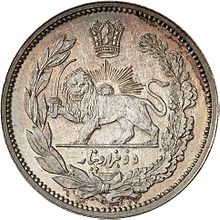
The qiran (Persian: قران; also Romanized kran) was a currency of Iran between 1825 and 1932. It was subdivided into 20 shahi or 1000 dinar and was worth one tenth of a toman. The rial replaced the qiran at par in 1932, although it was divided into one hundred (new) dinars. Despite the qiran no longer being an official denomination, the term still enjoys wide usage among Iranians.
Value
From 1874 to 1895, the value of the qiran depreciated by half relative to sterling, from 1 qiran equal to 9.6d. to 4.8d. (50 qirans for £1 stg), which then kept that value for the next few years.
In 1930, it was pegged to sterling at 59.75 qirans = £1 stg, although a regulated parallel market existed where the price of sterling is much higher than the aforementioned legal rate.
Coins
Until 1876, silver coins were minted in denominations of ⅛, ¼, ½ and 1 qiran. A milled coinage was introduced in 1876, with denominations of 12, 25, 50, 100 and 200 dinar, ¼, ½, 1, 2 and 5 qiran. Gold coins and banknotes were denominated in toman.
References
External links
- Iran Collection Archived 2021-01-26 at the Wayback Machine – a website about Persian banknotes and coins since Qajar era
| Preceded by: Iranian toman Reason: removed from Iranian currency by The King Ratio: 10 qiran = 1 toman |
Currency of Iran 1825 – 1932 |
Succeeded by: Iranian Rial Reason: modern economy Ratio: at par |
| Currencies named dinar or similar | |
|---|---|
| Circulating | |
| Defunct | |
| As subunit | |
| See also |
|
This article about a unit of currency is a stub. You can help Misplaced Pages by expanding it. |
This Iran-related article is a stub. You can help Misplaced Pages by expanding it. |